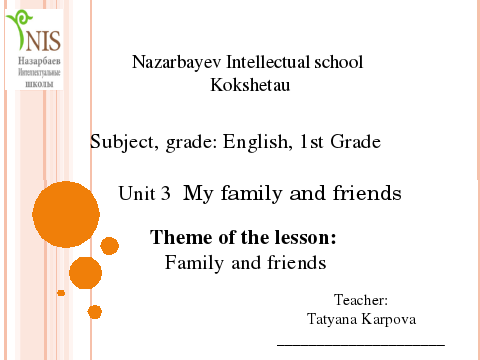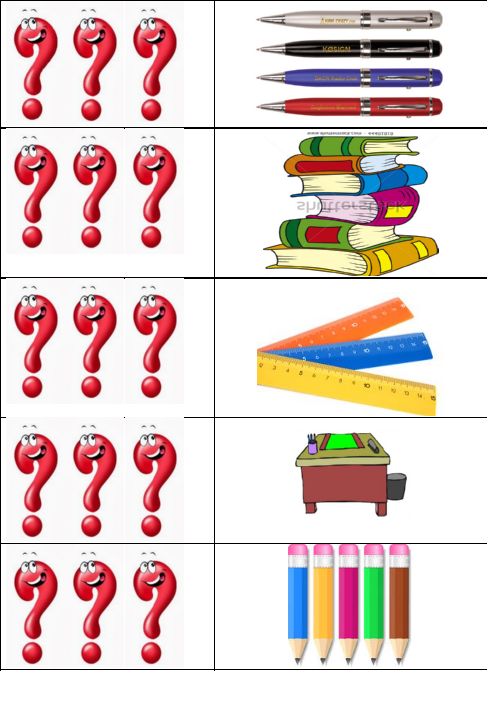LESSON: Unit 1
Family and friends
School: №2
Date: 28.10. -1 g, v
07.10. -1 d
08.11- 1 a, e
10.11 -1 b
Teacher name: Darkhambayeva Gulnara
CLASS: 1
Number present:
absent:
Learning objectives(s) that this lesson is contributing to
1.S1 make basic personal statements about people, objects and classroom routines
2.S3 pronounce familiar words and expressions intelligibly
3.UE1 use singular nouns, plural nouns – to talk about people and places,
use the personal pronouns.
Lesson objectives
All learners will be able to:
- listen and repeat the personal pronouns and family people
- recognise with support simple prompts the personal pronouns
Most learners will be able to:
- recognise and the personal pronouns I, You, He, She, We, They with to be
- name the plural nouns of the classroom objects.
Some learners will be able to:
- recognise and name the personal pronouns I, You, He, She, We, They with to be
- make basic simple statements: There are 4 pens on the table
Previous learning
About myself
Plan
Planned timings
Planned activities (replace the notes below with your planned activities)
Resources
Beginning
ORGANIZATIONAL MOMENT
Pre-teaching.
Teacher: How are you today?
Children: We are fine, thank you!
Teacher: Let’s dance today
Family people: watching the slides
and name: Mother/Father/Sister/Brother/Grandmother
/Grandfather/Aunt/Uncle.
Game: Count the School items
4 pens,6 books,3 rulers,1 table,5 pencils
PPT
Middle
Personal pronouns (10)
Teacher pre-teaches “boy/girl” by means of showing pictures. Students repeat the words after the teacher trying to memorize them and learn correct pronunciation.
Students write down the words into their copybooks.
After that teacher hands out cards with personal pronouns to stick into copybooks and introduces personal pronouns I, you, he, she, we, they using no translation but modelling. In order to check students’ learning teacher points at different students or groups of students in the class and elicits pronouns.
Dynamic break (2)
Students go to the carpet and have a dynamic break “Head, shoulders, knees & toes”
To be (13)
After that, teacher presents “to be” verb form (I am, he is, etc.) and models a couple of examples: She is a girl. He is a boy. We are boys and girls. and asks students to repeat the structures twice to memorize them.
Teacher nominates students to ask “Are /Is you/he/she a boy or a girl?” Students answer “I am/ he/she is a boy/girl” Each student answers 2-3 questions to memorize usage of the verb “to be”
At the end students write down two example sentences into their copybooks: I am a boy/girl. We are boys and girls.
Teacher asks students to exchange copybooks and check their peers’ works.
End
The ladder of success
Teacher goes back to the lesson objectives and offers students to look at the ladder of the success and identify which step each of them has reached by the end of the lesson and explain why they think so (with teacher support).
Good bye song
Students sing a good-bye song and dance to the tune repeating the moves shown in the video. Students sing a good-bye song and dance
Good-bye, good-bye, see you again!
Good-bye, good-bye, see you, my friend!
Crayons, worksheets
Additional information
Differentiation – how do you plan to give more support? How do you plan to challenge the more able learners?
Assessment – how are you planning to check learners’ learning?
Cross-curricular links
Health and safety check
ICT links
Values links
- Tasks were formulated at all levels according to Bloom’s Taxonomy levels
Support:
- Questions that do not have right or wrong answers
Challenging:
- Evaluative questions which promote further discussion.
- Application questions that allow students to relate the topic to their own lives and experiences.
- through questioning and the redirection of questioning in feedback activities
- through observing how pupils colour objects that are featured in the song
- through formative task
- through observing how pupils identify the coloured animals from the book
- Cross curricular link with Art and Music, Literature
- Learners will be safely arranged and seated in front of the monitor away from electrical outlets and cables.
- Use water based markers
- Use water based paints
- Ensure proper ventilation for painting
- Potentially hazardous components include graphite and some pigments in colored pencils
- E-book: White Rabbit’s Color Book by Alan Baker
- Students learn to be patient and helpful through pair work
Reflection
Were the lesson objectives/learning objectives realistic?
What did the learners learn today?
What was the learning atmosphere like?
Did my planned differentiation work well?
Did I stick to timings? What changes did I make from my plan and why?
Use the space below to reflect on your lesson. Answer the most relevant questions from the box on the left about your lesson.
Summary evaluation
What two things went really well (consider both teaching and learning)?
1:
2:
What two things would have improved the lesson (consider both teaching and learning)?
1:
2:
What have I learned from this lesson about the class or individuals that will inform my next lesson?





















